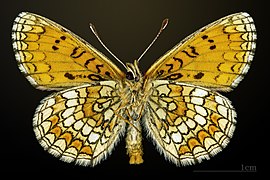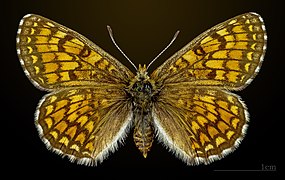Melitaea parthenoides
| Melitaea parthenoides | |
|---|---|

| |
| Scientific classification | |
| Kingdom: | |
| Phylum: | |
| Class: | |
| Order: | |
| Family: | |
| Genus: | |
| Species: | M. parthenoides
|
| Binomial name | |
| Melitaea parthenoides Keferstein, 1851
| |
| Synonyms | |
| |
Melitaea parthenoides, the meadow fritillary, is a butterfly of the family Nymphalidae. Note that the common name meadow fritillary is also used for the North American species Boloria bellona.
Distribution[]
It is found in south-western Europe, more specifically on the Iberian Peninsula, south-western France, parts of the Italian Alps and southern and south-western Germany and a few regions of Switzerland.
Description[]
The wingspan is 28–34 mm. Seitz- M.parthenie Brk. (= parthenoides Kef.) (67a). Above very similar to athalia, especially in pattern, but the black markings much thinner, yellowish red the prevalent colour. While in aurelia and athalia the yellowish red spots may be said to be united to bands, parthenie has orange bands of almost even width and traversed by thin black veins; the median band especially is very broad, the spots composing it being almost twice as long as wide, which is hardly ever the case in European athalia. The underside likewise resembles athalia in pattern, but is brighter, more variegated, the black edges of the various bands being more prominent, the colours contrasting more distinctly.[1]

Male

Male underside

Female

Female underside
Biology[]
In dry, favourable climates, adults are on wing in two generations, from May to June and from August to September. At high altitudes, there is one generation from June to July. The larvae feed on Plantago species, mainly P. lanceolata.
References[]
- ^ Seitz. A. in Seitz, A. ed. Band 1: Abt. 1, Die Großschmetterlinge des palaearktischen Faunengebietes, Die palaearktischen Tagfalter, 1909, 379 Seiten, mit 89 kolorierten Tafeln (3470 Figuren)
 This article incorporates text from this source, which is in the public domain.
This article incorporates text from this source, which is in the public domain.
External links[]
| Wikimedia Commons has media related to Melitaea parthenoides. |
- lepiforum.eu
- "Melitaea Fabricius, 1807" at Markku Savela's Lepidoptera and Some Other Life Forms
- Fauna Europaea
- Melitaea
- Butterflies of Europe
- Taxa named by Wilhelm Moritz Keferstein
- Butterflies described in 1851
- Nymphalinae stubs



